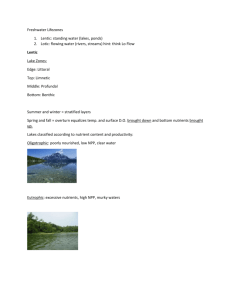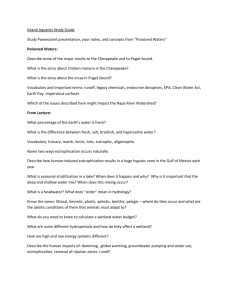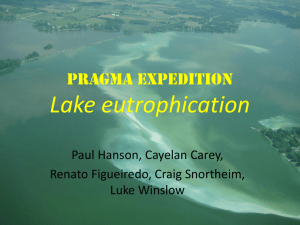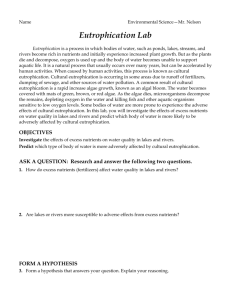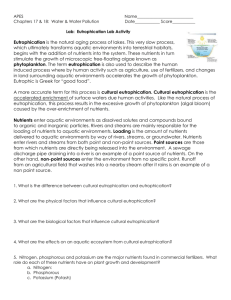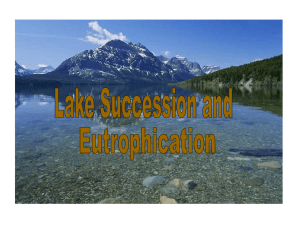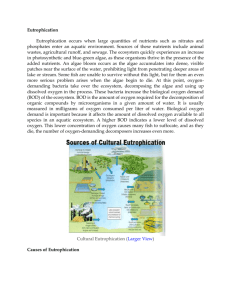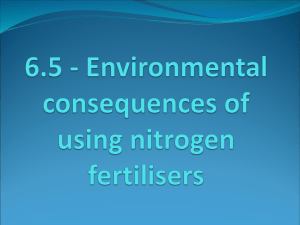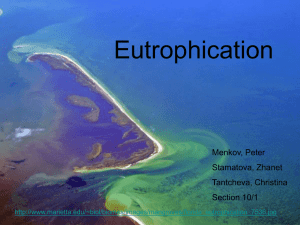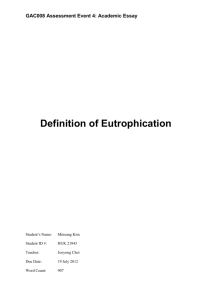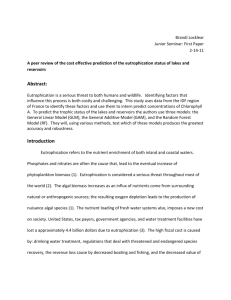Causes of Eutrophication
advertisement
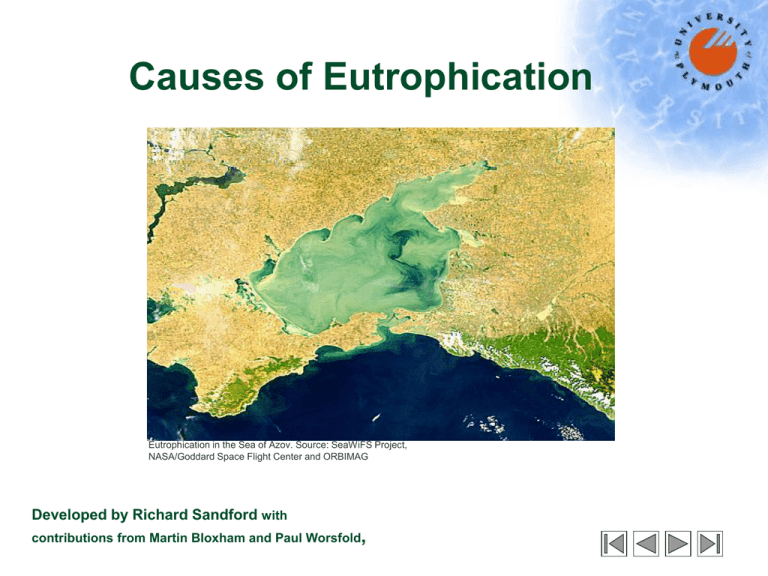
Causes of Eutrophication Eutrophication in the Sea of Azov. Source: SeaWiFS Project, NASA/Goddard Space Flight Center and ORBIMAG Developed by Richard Sandford with contributions from Martin Bloxham and Paul Worsfold, Eutrophication – Causes 2.1 Enhanced nutrient inputs Eutrophication is caused by enhanced nutrient inputs (N and P) as a result of: Inorganic fertilisers and animal wastes in crop Combustion of fossil fuel production Wastes from animal production Combustion of fossil fuel Forestry practices Agricultural practices Phosphate detergents Sewage discharges Aquaculture Draining of wetlands Sewage discharges Soil and sediment erosion, remobilisation, leaching (from agriculture, mining, construction) Example: Effects of Agricutlure Wastes from animal production Soil erosion on lakes Eutrophication – Causes 2.2 Increased recycling/mobilisation of nutrients Eutrophication is also caused by Increased recycling/mobilisation of nutrients as a result of: Forestry practices Water impoundment Forestry practices Draining of wetlands Water system impoundment (e.g. reservoirs) Soil and sediment erosion, remobilisation, leaching (e.g. As a result of agriculture, mining, construction) Question: What is a Causal Chain? Soil erosion Draining of wetlands Eutrophication – Causes 2.3 Trapping of nutrients (e.g. in river impoundments) Eutrophication is also caused by Trapping of nutrients (e.g. in river impoundments) as a result of: Water system impoundment Soil and sediment erosion, remobilization, leaching (e.g. As a result of agriculture, mining, construction) Soil erosion Water impoundment Water impoundment Question: What uncertainties are there when determining causes? Eutrophication – Causes There are over 600 small lakes in Northern Ireland. Research on the sediments in six of these has reconstructed a remarkable record of changes in total phosphorus concentration over the past 150 years that appears to be typical of lakes in most developed countries. The data shown above is for three lakes that have no point sources (e.g. sewage) draining into them, only the inputs from surrounding agriculture. Each of the lakes shows an increase in phosphorus, initially as a result of land clearances (ploughing releases phosphorus) and then a more pronounced increase since the 1950s. This recent large change is due to land drainage, fertiliser use and the indirect impact of rural sanitation. Impacts of these activities are accelerating the demise of the lakes. Each of the lakes is affected in a slightly different manner according to the characteristics of the particular drainage basin. Recent decreases may reflect more prudent use of fertilisers. source: redrawn from Anderson, J. Freshwater. Biol. 38, 427-440, Fig. 9 Eutrophication – Causes Causal chains Immediate causes a. Enhanced Nutrient Inputs b. Increased recycling/ Mobilization c. Trapping of nutr ients (e.g. River impoundments) Secondary causes Tertiary causes 1. Use of fertilizers in crop production (a) 2. Use of animal wastes in agriculture (a) 3. Wastes from animal production (a) 4. Combustion of fossil fuel (a) 5. Forestry/ Agricultural practices (a,b) 6. Phosphate detergents (a) 7. Sewage discharges (a) 8. Aquaculture (a) 9. Draining of wetlands (a,b) 1. Enhanced food production via use of fertilizers (a) 2. Intensification of animal production (a) 3. Enhanced energy demand (a,c) 4. Urbanization (a) 5. Enhanced aquacultural production (a) 6. Land-use changes (a,b) 7. Enhancement of navigation, dredging of waterways and harbours (b) 8. Enhancement of water supplies (b,c) 9. Hydrolelectric power development (b,c) Policy management failur es 1. Lack of internalization of costs of environmental degradation 2. Inadequate development and/or enforcement of regulations Enhanced nutrient input is the Immediate Cause of eutrophication. The Secondary Cause could be the use of fertilisers in crop production. The Tertiary Cause may be the intensification of animal production. This could be as a result of Policy Management Failures. This stepwise process is known as a Causal Chain. A Causal Chain is a series of statements that demonstrate and summarise, in a stepwise manner, the linkages between problems and their underlying or 'root' causes. Eutrophication – Causes Uncertainties in determining causes 1. Relative importance of given sources in a given situation (temporal and spatial variance) 2. Level/input rates of nutrients that give rise to exceptional algal blooms 3. Limitations of information on the incidence and bio-availability of forms of nutrients (N & P) 4. Uncertainties in the precision of comparisons among options 5. Uncertainty in the prediction of the outcome of management interventions
